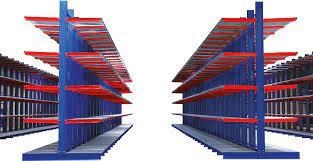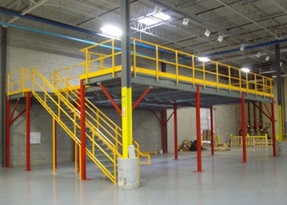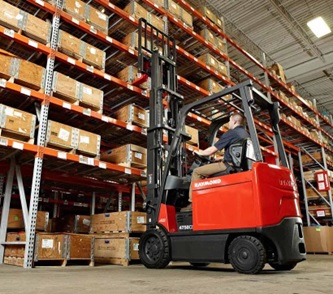The importance of having good flooring in the warehouse is pivotal, as it takes the burden of tonnes of the weight of racking and goods, as well as the continuous transit of machines and workers, so its quality is vital. The common loads on floors in warehouses are the point loads from pallet racking and materials handling equipment (MHE) and from mezzanines. Other loads arise from uniformly distributed loads (UDL) such as stacking of palletised products or bulk loose materials.
Difference between Static and Dynamic loads?
Static loads
Static loads are distributed across the floor of the warehouse, concentrated on a specific surface area where the upright of the racking makes contact with the flooring. They do not move or change location, although their magnitude may vary slightly over time.
Dynamic loads
They are loads whose magnitude and location do vary over time. They are mainly the forklifts and other handling equipment that perform their daily operations in the warehouse aisles.
The purpose of flooring is to withstand and transfer the loads from the surface of the floor downwards until they reach the subsoil level. This applies both to dynamic loads (produced by devices in movement) and static loads (loads generated by the racking unit pillars). Therefore, suitable flooring is that which has the strength and stability required to meet these requirements.
STATIC LOADS IN WAREHOUSE FLOORS
There are three types of static load;
- Uniformly distributed loads- these loads are generally larger footprint distributed loads. In commercial buildings floors are designed for nominal loading, which are substantially lower than the distributed loads in industrial areas. When machines and production equipment are installed directly on the floors, their foundation can be regarded as a uniform load.
- Line loads, as the name suggests, are loads that act along a line. The storage systems and other fixed equipment are mounted on rails. Where such rails are loaded along their full length and are in direct contact with the floor, they should be considered as line loads; where such rails are used by moving equipment.
- Point loads-arising from any equipment or structure mounted on legs with baseplates and from materials handling equipment. Fixed conveyor systems deliver a variable point loading and require vibration consideration. The most common static point loads are from storage racking.
Static storage systems in warehouses
The floor design should also take into account such permanent loads incurred from storage systems installed. Different types of static storage systems include.
Adjustable pallet racking (APR)

Pallet racking is used for the storage of products on pallets at up to considerable heights while providing access to the individual pallets. APR consists of frames of pairs of uprights connected by bracing. Beams supporting the pallets span between these frames. Pallets are commonly stored directly on the floor slab beneath the racking. Where rail-guided MHE is used, the first level of pallets is carried on beams close to floor level.
Mobile pallet racking

This consists of sets of racks on mobile chassis running on floor-mounted rails. The racks are individually driven by electric motors so that each aisle can be opened up as required for access to individual pallets.
Pick and deposit (P&D) stations

These are used at the end of narrow aisles or very narrow aisle racking bays. They can be either marked out on the floor or form part of the racking structure; in the latter case, the uprights supporting the P&D stations may carry increased loads.
Live storage systems

The storage system provides a high-density block of loads without load selectivity.. Incoming pallets are placed on the ‘high’ end of a downward sloping set of roller conveyors. As loads are removed from the ‘low’ end, the pallets move by gravity towards the outlet end of the racking.
Drive-in racking

In this racking system, there is no division by aisles and therefore high storage density is achieved. Cantilever brackets attached to the racking frames support the pallets. This type of racking can be up to about 12m high. Cantilever brackets attached to the racking frames support pallets. Compared to very narrow aisle (VNA) racking, more of the available space can be used and the height is limited by the strength of the racking. The self-weight and configuration of the racking may mean that the applied point loads are unequally distributed among the rack upright.
Push-back racking systems

These provide a high-density block of loads. Incoming pallets are placed on the push-back carrier; subsequent loads are positioned on the next available carrier and used to push the previous load back up a slope.
Cantilever racks

These racks are used to store long loads and are sometimes referred to as ‘bar racks’. The racks consist of a row of uprights with arms cantilevering out on either or both sides and are often used in conjunction with side-loading fork-lift trucks.
Mezzanines

These are used for production, handling machinery and storage. Column base plates should be designed to provide the required load-spreading capability in mezzanines.
Clad rack structures

In clad rack structures the racking itself provides the structural framework for the building and supports the walls and roof. Clad rack warehouses can be up to 45m high and the point loads can be extremely high and at close centres.
DYNAMIC LOADS IN WAREHOUSES
To design floors to support MHE loads, the all-up weight of the trucks must be known, along with maximum axle and individual wheel loads and contact areas of the wheels.
MHE types used in warehouses
The carrying capacity of the MHE is not an adequate indicator of the loads applied to a floor. The maximum wheel loadings and contact areas of wheels or tyres must be known. Equipment configurations and weights vary significantly and so manufacturers should be consulted. Different types of MHE used in warehouses include;
MHE operating at floor level

Pallet trucks are used at floor level for moving single or multiple pallets and for order picking. They can be controlled by pedestrians alongside or operators riding on them. Truck capacities do not usually exceed 3 tonnes, but can be higher in specialist applications. The trucks have small load-carrying wheels and so local load concentrations can be high.
MHE operating in free-movement areas and wide aisles
Counterbalance trucks

These are fork-lift trucks fitted with telescopic masts with the load carried ahead of the front (load) wheels. They are used within buildings and externally for block-stacking, in storage racking up to about 7 m high and for general materials movement. Because they approach stacking and racking face-on, aisle widths are generally more than 3m. Truck tyres are usually solid rubber or pneumatic. Rubber tyres can be aggressive on dusty or wet floor surfaces and it is important to keep floors clean to avoid such conditions. Counterbalance trucks can tolerate relatively uneven surfaces and joints.
Reach trucks

These have moving telescopic masts and transport the load in a retracted position within the truck wheelbase. They can operate in narrow aisles up to 3 m wide and have a typical load capacity of 2 tonnes. They normally operate in aisles of 3m or more. Lift heights do not normally exceed 10–12m. Truck tyres are generally of polyurethane, which are not unusually aggressive to surfaces but can damage joints. Floor surfaces should be flat and level with no wide, stepped or uneven joints.
MHE operating in very narrow aisles
Front and lateral stackers (VNA trucks)

These lift trucks handle pallets at right angles to the direction of travel and are also known as very narrow aisle (VNA) trucks. Operators travel at floor level or in a compartment that lifts with the forks; these are known as ‘man-down’ and ‘man-up’ trucks respectively. In very narrow aisles, trucks run in defined paths and so it is appropriate to measure and control the flatness of each of the tracks. Most trucks have three wheels, two on the front load axle and one drive wheel at the rear. Some have two close-coupled wheels at the rear acting as one wheel. A few trucks have four wheels with one at each ‘corner’. When operating in the aisles, the trucks are guided by rails at the sides of the aisle or by inductive guide wires on the floor and are not directly controlled by the operator.
Stacker cranes

These cranes run on floor-mounted rails. They have fixed masts with a top guidance rail and can transfer between aisles utilising special rail links. There are no onerous floor flatness requirements as the rails are set level with shims. However, the floor should have a good overall level to datum as the racking and rails are fixed level to a datum. Limiting long-term settlement of slabs is important for stacker crane installations as changes in levels can lead to operational problems.
Conclusion
To ensure that the warehouse concrete floor will continue to carry its design loading successfully importance needs to be given to floor load-carrying ability, sub-grade compaction, concrete mix, controlling cracks, treating joints, appropriate tolerances and abrasion resistance of the warehouse floor. In all cases, the floor design should be based on anticipated loads from all forms of equipment and other loads should take into account future possible uses of the floor.
Analysis of Warehouse storage system and Material Handling Equipments
Difference between static and Dynamic loads
STATIC LOADS IN WAREHOUSE FLOORS
Static storage systems in warehouses
Adjustable pallet racking (APR)
Pick and deposit (P&D) stations
MHE operating in free-movement areas and wide aisles
MHE operating in very narrow aisles

